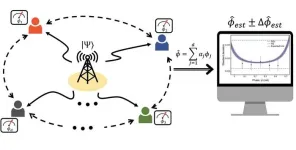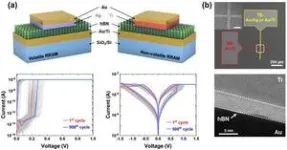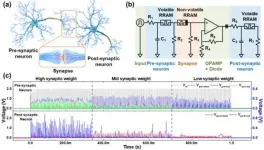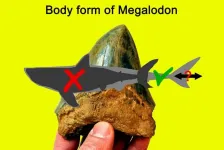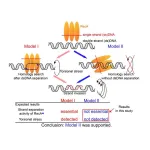(Press-News.org) We've all had the experience of trying to get the exact time of a highly competitive concert ticket or class beforehand. If the time in Seoul and Busan is off by even a fraction of an hour, one will be less successful than the other. Sharing the exact time between distant locations is becoming increasingly important in all areas of our lives, including finance, telecommunications, security, and other fields that require improved accuracy and precision in sending and receiving data.
The Korea Institute of Science and Technology (KIST) announced that Dr. Hyang-Tag Lim and his team at the Center for Quantum Information, in collaboration with leading domestic and international research institutes such as Chung-Ang University, the Korea Research Institute of Standards and Science (KRISS), the Agency for Defense Development (ADD), and the Oak Ridge National Laboratory (ORNL) in the United States, have succeeded in implementing a distributed quantum sensor that can measure multiple spatially-distributed physical quantities with high precision beyond the standard quantum limit with few resources.
Quantum phenomena such as superposition and entanglement can be used to more precisely measure the time of different clocks in two distant spaces. Similarly, if you have two physical quantities, one in Seoul and one in Busan, you can share the entanglement state in Seoul and Busan and then measure the two physical quantities simultaneously with greater precision than if you measure the physical quantities in Seoul and Busan separately. There is an expectation that quantum sensors will enable ultra-precise measurements that are not possible with classical sensors, and 'distributed quantum sensors' are systems that can measure distributed multiple parameters over a large area with higher precision than conventional sensors.
The KIST research team has experimentally demonstrated that distributed quantum sensing systems can be used to measure phenomena with the highest precision achievable with quantum mechanics in situations where the objects to be measured are distributed over a large area. The team experimentally generated a superposed maximum entanglement state that simultaneously exists in four spaces far apart from the Bell state, a quantum entanglement state, and applied it to reach the Heisenberg limit, the limit of quantum mechanical precision.
"We look forward to expanding into practical technologies such as global time synchronization and ultra-microscopic cancer detection by pioneering the core source technology for distributed quantum sensing, which enables measurements beyond the standard quantum limit with few resources," said Dr. Hyang-Tag Lim of KIST, who led the study. KIST conducts open R&D projects to secure world-class source technologies in quantum applications, including quantum sensors, and disseminate them to industry, and is working with various researchers from industry, academia, and research centers, including first author Seongjin Hong, a professor at Chung-Ang University.
###
KIST was established in 1966 as the first government-funded research institute in Korea. KIST now strives to solve national and social challenges and secure growth engines through leading and innovative research. For more information, please visit KIST’s website at https://eng.kist.re.kr/
This research, which was supported by the Ministry of Science and ICT (Minister Lee Jong-ho) through the KIST Major Project (2E32241) and the Information and Communication Technology Planning and Evaluation Institute (IITP) Quantum Sensor Core Strategic Technology Development Project (RS-2023-0022863), was published on January 11 in the international journal Nature Communications (IF: 16.6, JCR(%) 7.5). on January 11th.
END
Enable distributed quantum sensors for simultaneous measurements in distant places
Implementing the 'neuron-synapse-neuron' basic unit structure in hardware for high-performance, low-power neuromorphic computing. Same material, same structure for processability and network scalability.
2024-01-22
ELSE PRESS RELEASES FROM THIS DATE:
Implement artificial neural network hardware systems by stacking them like "neuron-synapse-neuron" structural blocks
2024-01-22
With the emergence of new industries such as artificial intelligence, the Internet of Things, and machine learning, the world's leading companies are focusing on developing next-generation artificial intelligence semiconductors that can process vast amounts of data while consuming energy efficiently. Neuromorphic computing, inspired by the human brain, is one of them. As a result, devices that mimic biological neurons and synapses are being developed one after another based on emerging materials and structures, but research on integrating individual devices into a system to verify and optimize them ...
The megalodon was less mega than previously believed
2024-01-22
A new study shows the Megalodon, a gigantic shark that went extinct 3.6 million years ago, was more slender than earlier studies suggested. This finding changes scientists’ understanding of Megalodon behavior, ancient ocean life, and why the sharks went extinct.
The Megalodon or megatooth shark is typically portrayed as a super-sized monster in popular culture, with recent examples in the sci-fi films “The Meg” (2018) and “Meg 2: The Trench” (2023). Previous studies assume that the shark likely reached lengths of at least 50 feet and possibly as much as 65 feet.
However, the Megalodon is largely known only from its teeth and vertebrae in the ...
Slender shark: Study finds Megalodon was not like a gigantic great white shark
2024-01-22
CHICAGO — A new scientific study shows that the prehistoric gigantic shark, Megalodon or megatooth shark, which lived roughly 15-3.6 million years ago nearly worldwide, was a more slender shark than previous studies have suggested.
Formally called Otodus megalodon, it is typically portrayed as a super-sized, monstrous shark in novels and sci-fi films, including “The Meg.” Previous studies suggest the shark likely reached lengths of at least 50 to 65 feet (15 to 20 meters). However, ...
New criteria for sepsis in children based on organ dysfunction
2024-01-21
Clinician-scientists from Ann & Robert H. Lurie Children’s Hospital of Chicago were among a diverse, international group of experts tasked by the Society of Critical Care Medicine (SCCM) with developing and validating new data-based criteria for sepsis in children. Sepsis is a major public heath burden, claiming the lives of over 3.3 million children worldwide every year. The new pediatric sepsis criteria – called the Phoenix criteria – follow the paradigm shift in the recent adult criteria that define sepsis as severe ...
Development and validation of the Phoenix criteria for pediatric sepsis and septic shock
2024-01-21
About The Study: In this international, multicenter, retrospective cohort study including more than 3.6 million pediatric encounters, a novel score, the Phoenix Sepsis Score, was derived and validated to predict mortality in children with suspected or confirmed infection. The new criteria for pediatric sepsis and septic shock based on the score performed better than existing organ dysfunction scores and the International Pediatric Sepsis Consensus Conference criteria.
Authors: Tellen D. Bennett, M.D., M.S., of the University of Colorado School of Medicine and Children’s Hospital Colorado in Aurora, is the corresponding author.
To access the ...
International consensus criteria for pediatric sepsis and septic shock
2024-01-21
About The Study: The Phoenix sepsis criteria for sepsis and septic shock in children were derived and validated by the international Society of Critical Care Medicine Pediatric Sepsis Definition Task Force using a large international database and survey, systematic review and meta-analysis, and modified Delphi consensus approach. A Phoenix Sepsis Score of at least 2 identified potentially life-threatening organ dysfunction in children younger than 18 years with infection, and its use has the potential to improve clinical care, epidemiological assessment, and research in pediatric sepsis and septic shock around the world.
Authors: R. Scott ...
CU researchers unveil modernized criteria for pediatric sepsis and septic shock
2024-01-21
An international research team led by Tell Bennett, MD, MS, professor of biomedical informatics and pediatric critical care at the University of Colorado School of Medicine, released new diagnostic criteria for sepsis in children this week, marking the first update to the pediatric sepsis definition in nearly two decades.
The updated criteria, presented at the 2024 Critical Care Congress of the Society for Critical Care Medicine (SCCM), will be utilized ...
A computerized decision support system significantly reduces high-risk drug combinations in Intensive Care patients
2024-01-21
A recent multicentre study led by Amsterdam UMC and conducted in nine Dutch Intensive Care Units (ICUs) has shown that tailoring a computerised decision support system (CDSS) to the ICU environment significantly reduced the number of high-risk drug combinations administered to ICU patients. It also improved monitoring ICU patients when avoiding such combinations was not possible, and reduced the length of patients’ stay in the ICU. This study is published today in The Lancet.
"Not more, but fewer and more relevant alerts by a CDSS make such a system more valuable for healthcare providers and patients," says Amsterdam ...
Scientists unravel key steps in the road to DNA repair
2024-01-20
Tokyo, Japan – Researchers from Tokyo Metropolitan University have been studying DNA repair by homologous recombination, where the RecA protein repairs breaks in double-stranded DNA by incorporating a dangling single-strand end into intact double strands, and repairing the break based on the undamaged sequence. They discovered that RecA finds where to put the single strand into the double helix without unwinding it by even a single turn. Their findings promise new directions in cancer research.
Homologous recombination (HR) is a ubiquitous biochemical process shared across all living things, including animals, plants, fungi, and bacteria. As we go about our daily ...
Study identifies new PD-1 immune checkpoint mechanism promoting merkel cell carcinoma growth
2024-01-19
Programmed cell death 1 (PD-1) is an important target for immune checkpoint inhibitor therapies that block its signaling and boost T-cell activity. PD-1 inhibitors have been approved for treating various types of cancer.
But PD-1 functions can vary between different cell and cancer types, either promoting or suppressing disease progression. Merkel cell carcinoma (MCC), a rare and aggressive form of skin cancer, responds well to immune checkpoint inhibitor therapy. However, it was previously unknown if MCC cells express PD-1 themselves, and unclear how exactly cancer cell-intrinsic ...
LAST 30 PRESS RELEASES:
Decoupling the HOR enhancement on PtRu: Dynamically matching interfacial water to reaction coordinates
Sulfur isn’t poisonous when it synergistically acts with phosphine in olefins hydroformylation
URI researchers uncover molecular mechanisms behind speciation in corals
Chitin based carbon aerogel offers a cleaner way to store thermal energy
Tracing hidden sources of nitrate pollution in rapidly changing rural urban landscapes
Viruses on plastic pollution may quietly accelerate the spread of antibiotic resistance
Three UH Rainbow Babies & Children’s faculty elected to prestigious American Pediatric Society
Tunnel resilience models unveiled to aid post-earthquake recovery
Satellite communication systems: the future of 5G/6G connectivity
Space computing power networks: a new frontier for satellite technologies
Experiments advance potential of protein that makes hydrogen sulfide as a therapeutic target for Alzheimer’s disease
Examining private equity’s role in fertility care
Current Molecular Pharmacology achieves a landmark: real-time CiteScore advances to 7.2
Skeletal muscle epigenetic clocks developed using postmortem tissue from an Asian population
Estimating unemployment rates with social media data
Climate policies can backfire by eroding “green” values, study finds
Too much screen time too soon? A*STAR study links infant screen exposure to brain changes and teen anxiety
Global psychiatry mourns Professor Dan Stein, visionary who transformed mental health science across Africa and beyond
KIST develops eco-friendly palladium recovery technology to safeguard resource security
Statins significantly reduce mortality risk for adults with diabetes, regardless of cardiovascular risk
Brain immune cells may drive more damage in females than males with Alzheimer’s
Evidence-based recommendations empower clinicians to manage epilepsy in pregnancy
Fungus turns bark beetles’ defenses against them
There are new antivirals being tested for herpesviruses. Scientists now know how they work
CDI scientist, colleagues author review of global burden of fungus Candida auris
How does stroke influence speech comprehension?
B cells transiently unlock their plasticity, risking lymphoma development
Advanced AI dodel predicts spoken language outcomes in deaf children after cochlear implants
Multimodal imaging-based cerebral blood flow prediction model development in simulated microgravity
Accelerated streaming subgraph matching framework is faster, more robust, and scalable
[Press-News.org] Enable distributed quantum sensors for simultaneous measurements in distant placesImplementing the 'neuron-synapse-neuron' basic unit structure in hardware for high-performance, low-power neuromorphic computing. Same material, same structure for processability and network scalability.
